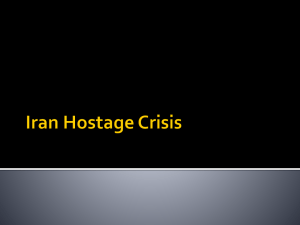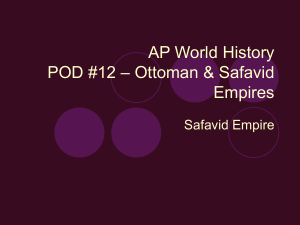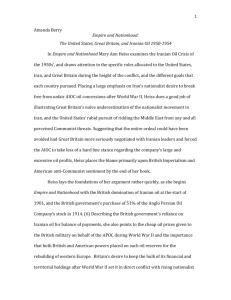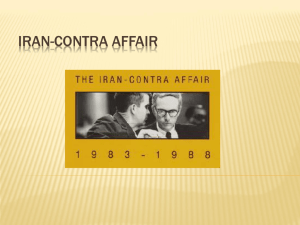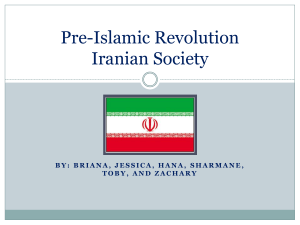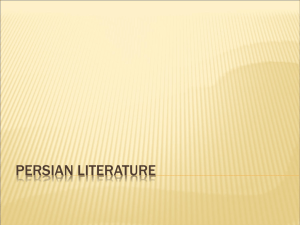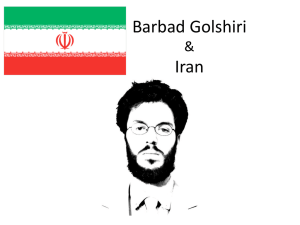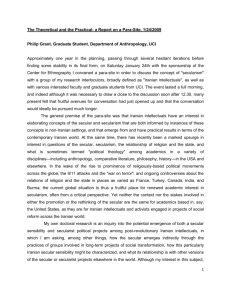Culture in Iran: Post- Islamic Revolution
advertisement
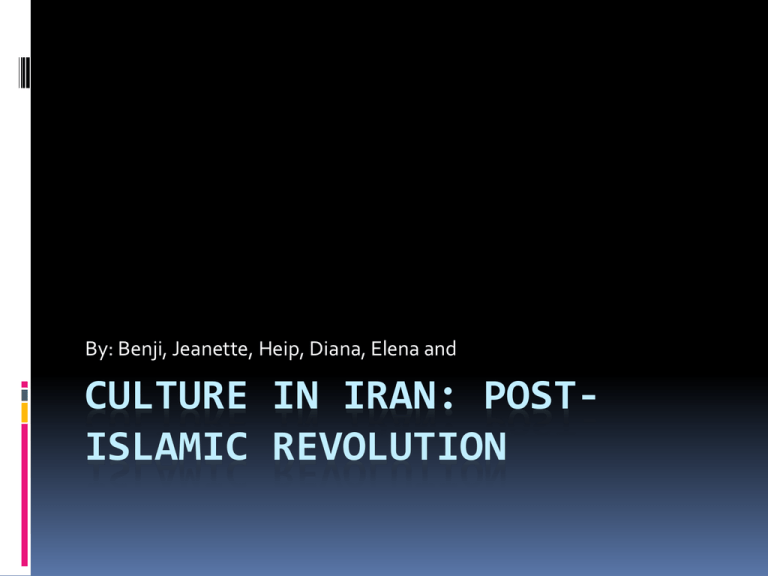
By: Benji, Jeanette, Heip, Diana, Elena and CULTURE IN IRAN: POSTISLAMIC REVOLUTION Iranian Cuisine A healthy diet that consists of fresh fruits and vegetables Unlike the U.S, meat (lamb, goat, or chicken) is not the centerpiece of meal Pork is prohibited The main beverage is Black Tea Gaz – a natural nougat that Iranians serves to guests Irainian adopted their dishes from the Greece and Indians The national dish is called chelow kebab which is lamb marinated in lemon juice. The main beverage with a meal is dough yougurt with salt water. Meals Breakfast- A light meal that usually consists of bread with butter, cheese, jam and tea Lunch is served around 1:00 in the afternoon. It starts with a plate of fresh greens (scallions, fresh basil, mint, and others that are in season. The main dish is aromatic steamed rice with stews made from meat and vegetables. Evening meal – Evening meal is a light meal consisting of leftover food from lunch. It can also be bread with cheese and fruits. Desserts Sweets are only eaten in the afternoon and with tea Borek Fruit Tarts Noon Khamei (Cream Puffs) Iranian Sports Most Popular- Soccer Iran have qualified for the 2014 World Cup in Brazil. Tehran was the first city in Western Asia to host the Asian Games. Iran have participated in every summer Olympics since 1948 other than 1980 and ‘84. Women and Sports Women must wear a head dress as they play sports to follow Islamic law. They must follow strict Islamic law when playing sports. If they break any of these laws there are severe punishments. Women can’t play sports where they could come into contact with male referees. Women are not allowed to attend outdoor soccer games. Iran Sports Diplomacy Iran came to USA and played Basketball against NBA teams. The tour was to “Bring people together.” Iran won’t play sport against Israel In 2012, Iran were supposed to play Serbian team, Partizan Belgrade, but Iran cancelled the match when Partizan hired an Israeli coach. In the 2008 an Iranian swimmer was forced to drop out of the Olympics due to being against an Israeli swimmer. Music and the Revolution During the revolution music was prohibited because of the ‘haram’. When this happened the musicians responded by creating music that was inspired by the traditional music, the political and social energy, and the revolution mentality. Directly after the revolution pop music was banned. Production of Music Music in Iran must be approved by the Ministry of Culture which combs through lyrics and instrumentations. Classic Persian music and pop have flourished under the restrictions but rock and hip hop have to stay mostly underground Women are not allowed to sing in public but by singing an asynchronous duet women are able to sing in front of the masses. Iranian Music Artists Shajarian sings traditional Iranian music Arash, Mansour and Manroosh are all pop artists in Iran and some of them use traditional Iranian music techniques to embellish their songs Moein is a popular artist in the adult contemporary genre. Iranian Women Fashion Modern day women can dress however they want, but they still have to abide by the traditional clothing requirements such as covering their hair, necks, and arms Most women wear a manteau (overcoat) which covers the body It is legal to wear something more revealing underneath their manteau Fashion Within If you are a woman and want to enter a holy place in Iran you will have to wear a chador. A chador is a long dress that is designed to cover every part of the female form except the face. If you are a man and you wish to enter a holy place it is better for you to have long sleeves but it is not mandatory. Iranian Men Fashion Men can dress freely They are allowed to wear t-shirts, tanks, jeans, and shorts Traditional Clothing Bakhtiari – a traditional dress that consists of many layers, and comes in different colors Graffiti/ Street Art Graffiti has become a new voice for Iran’s youth . Young Iranian stencil artists who are using street art to deal with themes such as peace, war, love, hate, hope, despair, human rights and the Iranian culture. Graffiti is almost considered a sin. Disney Graffiti These pictures shows Cinderella holding a knife and snow white is holding a gun. I think they are trying to represent the two country’s fighting. These princesses are mostly popular in America. When we take a look at Disney princesses we think about peace, nice and gentle but in this picture we see Disney princesses holding guns and knife. This picture could also represent how America looks very peaceful and nice but it could all be fake. Carpet Carpets are Iran's most important export item after oil, and their creation is an art of the highest order. The finest take years to complete and have hundreds of knots per square inch. Older carpets are worth more than new carpets. Every Iranian family will try to own one, with the secure knowledge that if they take care in their purchase it will always increase in value. Films Going to the theatre was banned because it did not follow their beliefs Films The Blue Veiled directed by Rakhashan Bani- E’temad (Russari Abi original title) 1995 Plot: an elderly owner who owns a tomato farm and sauce factory falls in love with one of the workers at the factory (after his wife dies). All of this endangers his relationship with his wife and kids Laila Magnu kaish Amari and Laila both came from wealthy families. They met at age of six and became close friends. As they grow older so does their love. Laila’s father expects her to marry a wealthy Arabian banksh a noble prince. Everyone knew about their love stony kaish becomes known as majnu and roams the desert without food nor drinks while Laila gets married off. Bibliography Zarghami, Mohammad Zarghami. "Pop Music in Iran." Pop Music in Iran. Iran, Daily Newspaper, 7 Apr. 2002. Web. 24 Sept. 2013. "The Iranian Times, Music, Revolutionary Pop Songs." The Iranian Times, Music, Revolutionary Pop Songs. Abadan Publishing Co., 6 Dec. 1999. Web. 24 Sept. 2013. Davies, Rodrigo. "Iran's Underground Rock Scene Thrives despite Censors." BBC News. BBC, 25 Mar. 2010. Web. 24 Sept. 2013. Kamalieh, Susanne. "Iranian.com: Post-revolutionary Iranian Music, Rasool Nafisi, Susanne Kamalieh." Iranian.com: Post-revolutionary Iranian Music, Rasool Nafisi, Susanne Kamalieh. Iranian.com, 19 May 2005. Web. 24 Sept. 2013. Shajarian, Mohammad Shajarian R. "Mohammad Reza Shajarian: NPR Music Tiny Desk Concert." YouTube. YouTube, 20 May 2013. Web. 24 Sept. 2013. Bari, Bakh. "Mansour - Bari Bakh." Bia2.com. Bia2.com, n.d. Web. 24 Sept. 201 "Countries and Their Cultures." Culture of Iran. JRank, n.d. Web. 25 Sept. 2013 "Street-art in Iran." Iran. Art Institution, n.d. Web. 25 Sept. 2013. Art Nerd New York." Art Nerd New York RSS. N.p., n.d. Web. 25 Sept. 2013 Zarrinpour, Bahman. "Paraaz Dar Qafas." Reza Norastefar, n.d. Web. 25 Sept. 2013.

